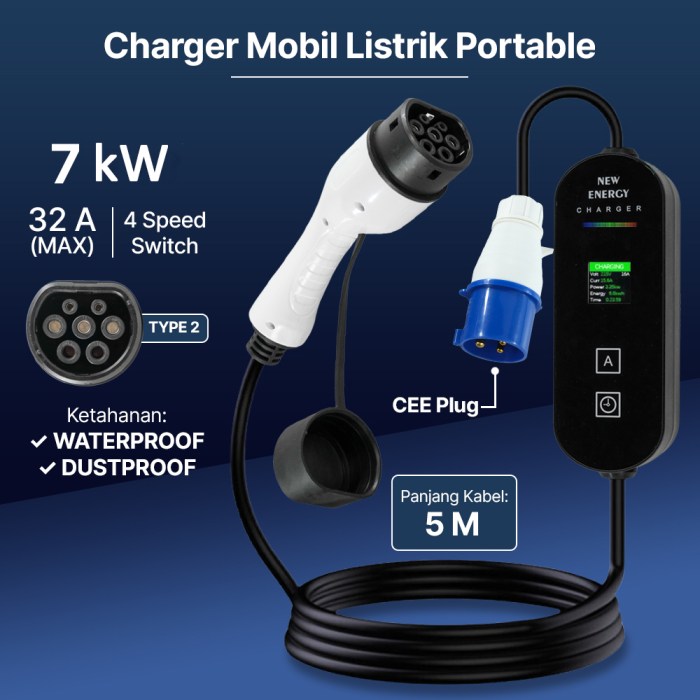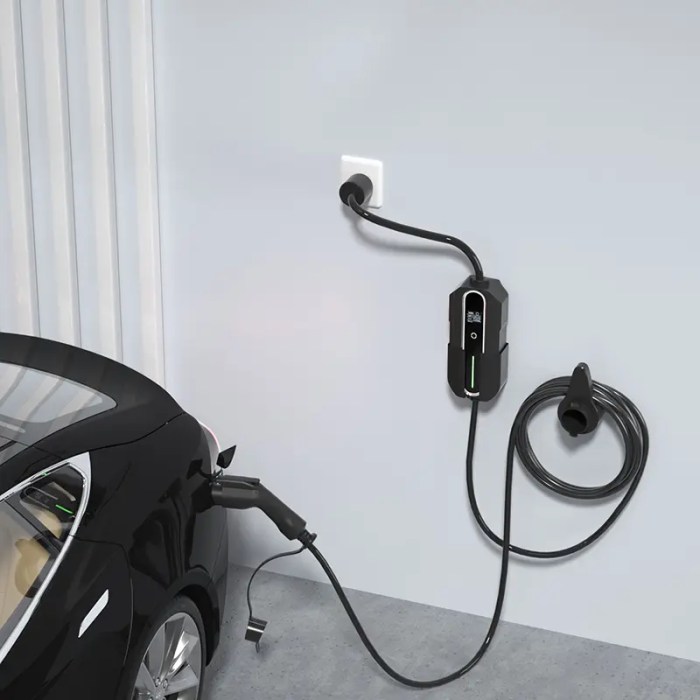Are you ready to dive into the world of EV chargers? From different types to installation and maintenance, this guide has got you covered. Let’s explore the essentials of charging your electric vehicle efficiently and effectively.
Whether you’re a newbie or a seasoned EV driver, there’s always something new to learn about EV chargers.
Introduction to EV Chargers
Electric Vehicle (EV) chargers are devices designed to recharge the batteries of electric vehicles, allowing them to run efficiently and sustainably.
There are several types of EV chargers available in the market, each with its own charging speed and compatibility:
Types of EV Chargers
- Level 1 Chargers: These chargers are typically used for home charging and operate on a standard 120-volt household outlet. They provide a slow charging speed, suitable for overnight charging.
- Level 2 Chargers: These chargers require a 240-volt outlet and offer a faster charging speed compared to Level 1 chargers. They are commonly found in public charging stations, workplaces, and residential settings.
- DC Fast Chargers: Also known as Level 3 chargers, these are the fastest charging option available for electric vehicles. They can charge an EV up to 80% in around 30 minutes, making them ideal for long-distance travel and quick top-ups.
Benefits of Using EV Chargers
- Convenience: EV chargers provide a convenient way to recharge your electric vehicle at home, work, or on the go.
- Cost Savings: Charging an electric vehicle is often cheaper than refueling a traditional gasoline-powered vehicle, leading to potential cost savings in the long run.
- Environmental Impact: By using EV chargers and driving electric vehicles, you can reduce greenhouse gas emissions and contribute to a cleaner and more sustainable environment.
Types of EV Chargers
In the world of electric vehicles, there are several types of chargers available to meet different needs and preferences. Understanding the differences between Level 1, Level 2, and DC fast chargers can help you make an informed decision when it comes to charging your EV.
Level 1 Chargers
Level 1 chargers are the most basic type of EV charger and are typically found in residential settings. They use a standard 120-volt household outlet to provide a slow charging speed, usually adding about 4-5 miles of range per hour of charging. While Level 1 chargers are convenient for overnight charging at home, they are not ideal for quickly topping up your battery.
Level 2 Chargers
Level 2 chargers are more powerful than Level 1 chargers and are commonly found in public charging stations, workplaces, and some residential settings. These chargers use a 240-volt outlet and can provide charging speeds of around 20-25 miles of range per hour. Level 2 chargers are ideal for daily charging needs and can fully charge most EVs overnight.
DC Fast Chargers
DC fast chargers, also known as Level 3 chargers, are the fastest type of EV chargers available. These chargers use direct current (DC) to provide rapid charging speeds, allowing EVs to charge up to 80% in as little as 30 minutes. DC fast chargers are typically found along highways and in commercial areas, making them ideal for long-distance travel and quick top-ups on the go.By understanding the differences in charging speeds and power outputs of each charger type, you can choose the option that best suits your lifestyle and charging needs.
Keep in mind that the cost implications of installing different types of EV chargers can vary, with DC fast chargers generally being more expensive to install due to their high power output requirements.
Installation and Setup

Installing an Electric Vehicle (EV) charger at home or setting up a commercial charging station requires careful planning and consideration. Here is a step-by-step guide on how to install a home EV charging station, the requirements for a commercial EV charging station, and the safety measures to keep in mind during the installation process.
Home EV Charging Station Installation
Installing a home EV charging station can be done by following these steps:
- Choose the right location for the charger near your parking spot and close to an electrical panel.
- Hire a certified electrician to assess your electrical system’s capacity and install the necessary wiring.
- Obtain any required permits from your local authorities before starting the installation.
- Mount the charger on the wall or a sturdy pole according to the manufacturer’s instructions.
- Connect the charger to the electrical panel and ensure proper grounding for safety.
- Test the charger to make sure it is functioning correctly before regular use.
Commercial EV Charging Station Requirements
Setting up a commercial EV charging station involves the following requirements:
- Obtain permits and approvals from local authorities and utility companies for the installation.
- Select a location with high visibility, convenient access, and sufficient parking spaces.
- Install multiple charging stations to accommodate simultaneous charging for multiple vehicles.
- Consider providing different charging speeds to cater to various EV models and user needs.
- Implement a payment system or subscription service for users to access the charging station.
- Ensure proper signage, lighting, and security measures for the safety of users and their vehicles.
Safety Measures for Installing an EV Charger
When installing an EV charger, it is essential to follow these safety measures:
- Turn off the power supply before starting any installation work to prevent electrical hazards.
- Use insulated tools and equipment to avoid electric shocks during the installation process.
- Ensure proper grounding of the charger and follow manufacturer’s instructions for safe installation.
- Avoid overloading electrical circuits by checking the capacity of your electrical panel and wiring.
- Regularly inspect the charger for any signs of damage or wear and tear to prevent accidents.
- Consider installing a ground fault circuit interrupter (GFCI) for added protection against electrical faults.
EV Charger Compatibility
When it comes to EV charger compatibility, it is essential to ensure that the charger you choose is compatible with your specific electric vehicle model. This compatibility is crucial for efficient and safe charging of your EV. Let’s dive into some key factors to consider.
Standardized Connectors
Standardized connectors play a vital role in determining the compatibility between an EV charger and an electric vehicle. Some of the common standardized connectors include:
- CCS (Combined Charging System): CCS is widely adopted in Europe and North America, offering both AC and DC charging capabilities.
- CHAdeMO: This connector is popular among Japanese electric vehicles and provides DC fast charging.
- Type 2: Type 2 connectors are prevalent in Europe and support AC charging.
Choosing the Right EV Charger
To ensure you select the right EV charger for your electric vehicle, consider the following tips:
- Check the connector type: Make sure the charger’s connector matches the port on your electric vehicle.
- Charging speed: Determine the charging speed your EV can handle to optimize charging times.
- Power output: Consider the power output of the charger to ensure it meets your vehicle’s charging needs.
- Smart features: Look for chargers with smart features like scheduling and monitoring capabilities for added convenience.
Maintenance and Troubleshooting

Regular maintenance is essential for keeping your EV charger operating smoothly and efficiently. By performing routine tasks and being aware of common issues, you can ensure that your EV charger remains in good working condition for a long time.
Regular Maintenance Tasks
- Inspect the charging cable and plug for any signs of wear or damage. Replace any damaged components immediately to prevent safety hazards.
- Clean the charging connector regularly to ensure a secure connection and efficient charging.
- Check the power supply and electrical connections for any loose wires or corrosion. Tighten connections as needed to maintain a reliable power source.
- Monitor the charging speed and efficiency to detect any unusual behavior that may indicate a problem with the charger.
Troubleshooting Tips for Common Issues
- If the EV charger is not charging the vehicle, check the power supply and electrical connections to ensure they are functioning correctly.
- If the charging cable is overheating during use, stop charging immediately and inspect the cable for damage. Replace the cable if necessary to prevent safety risks.
- If the EV charger is displaying error codes or warning lights, consult the user manual for troubleshooting steps or contact the manufacturer for assistance.
- If the charging speed is slower than usual, check for any obstructions in the charging port or connector that may be affecting the charging process.
Importance of Firmware Updates
Firmware updates are crucial for maintaining optimal performance and compatibility with your EV charger. These updates often include bug fixes, security enhancements, and new features that can improve the overall functionality of the charger. Make sure to regularly check for firmware updates from the manufacturer and install them as recommended to ensure your EV charger operates at its best.
Last Point
In conclusion, understanding EV chargers is key to maximizing the performance of your electric vehicle. With the right knowledge and tools, you can charge up hassle-free and embrace the future of sustainable transportation.